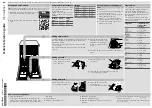
Chemical processes and technology
36
Soiling
Problem
How to resolve it
The following substances can damage
elastomers (hoses and seals) and plastics in
the washer-disinfector:
– oil, wax, aromatic and unsaturated hydro-
carbons,
– emollients,
– cosmetics, hygiene and care products
such as creams (analytical applications).
– Refit the washer-disinfector with oil resist-
ant elastomers.
– Depending on usage wipe the lower door
seal on the washer-disinfector periodically
with a lint-free cloth or sponge. Clean the
wash cabinet and accessories without a
load using the ORGANIC programme.
– Prepare the load using the "OIL" pro-
gramme (where this is available) or use a
special programme that dispenses emul-
sifiers.
The following substances can lead to a
heavy build-up of foam during washing and
rinsing:
– some disinfecting agents and dishwash-
ing detergents,
– reagents for analysis e.g. for microtiter
plates,
– cosmetics, hygiene and care products
such as shampoos and creams (analytical
applications),
– active foaming agents such as tensides.
– Thoroughly rinse items in water before-
hand.
– Select a cleaning programme with at least
one short pre-rinse in cold or hot water.
– Depending on application use de-foaming
agents that do not contain silicone oils.
The following substances cause corrosion
to stainless steel in the wash cabinet on ac-
cessories:
– hydrochloric acid,
– other substances containing chlorides
such as sodium chloride etc.,
– concentrated sulphuric acid,
– chromic acid,
– particles of iron and swarf.
– Thoroughly rinse items in water before-
hand.
– Place items drip dried into mobile units,
baskets and inserts and then place these
in the wash cabinet.
















































